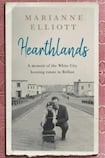
The peace walls still disfiguring parts of Belfast and the city’s long saga of sectarian tensions that in many places established segregated communities, help perpetuate the idea that this our indelible history. Marianne Elliott’s memoir of growing up in the White City, one of the first mixed-religion housing estates created after the second World War, is a timely and welcome reminder that there are other, perhaps less well-known stories that deserve expression. With the same scholarly skills that distinguished her academic career, Elliott illuminates the post-war pre-Troubles period of Belfast’s history, the decades perhaps that have had less attention than those marked by Semtex and sectarian slaughter. And despite the warm glow of the title and Elliott’s deep affection for the life she experienced in the White City, this is a clear-eyed, meticulously researched and ultimately important work of social history.
The estate into which the Elliott family moved in 1949 was situated in the hinterland between Cave Hill and Belfast Lough, its rural surroundings offering an Arcadian playground for children and where if she swung high enough “you had the sensation of flying over Belfast Lough”. The Orlit-built houses were made from precast reinforced concrete and both in terms of their size and the provision of indoor toilets represented a dramatic improvement in a city nurturing some of the worst slums of any industrial city in the UK, with high rates of child mortality and tuberculosis. The families who inhabited the new homes were of mixed religion and soon established a community distinguished by good neighbourliness and a shared pride in their environment. Elliott draws on her memories and those of other inhabitants to create a portrait of a “neighbourhood” where differences of faith are simply subsumed into the daily practicalities of living.
Forgotten heroes emerge, not least William Grant, a former shipwright and unionist politician who sees off those who questioned giving workers 'luxuries like bathrooms'
Forgotten heroes emerge, not least William Grant, a former shipwright and Unionist politician with labour sympathies, who becomes the minister of Health and Local Government and oversees the formation of the Northern Ireland Housing Trust in 1945, seeing off opposition from his own political tribe, some of whom questioned the idea of giving workers “luxuries like bathrooms”. The Trust is legislatively separated from local councils where the allocation of housing was often determined on a sectarian basis – the tinder that would later ignite the Civil Rights movement. Elliott is full of admiration for the Trust, who approach their work with a desire to create communities and have a keen awareness of aesthetics and a determination to incorporate communal space. A strict points system selects tenants. Paternalistic in some of its approaches, it also manages to be maternalistic, with the teams of female managers who collect the rent also trained to offer advice and help with all aspects of life on the estate.
It is often a temptation to broad-brush particular periods of history and so it is easy to view the 1950s as a period of grey austerity. Again Elliott challenges this simplistic generalisation and writes of a time when "Belfast came alive" and details the blossoming of entertainment and recreational activities. When the Lido cinema, the closest one to the White City, opens in March 1955 all 1,050 seats are taken, with others standing. Thousands flock to sporting events and the dances held in Bellevue's Floral Hall. And if shadows fall across the district such as the sinking of the Princess Victoria and the still unsolved murder of Patricia Curran, they fade away again as life resumes its familiar rhythms.
It is the Troubles that see the demise of White City’s integrated community. In the 1950s some 27 per cent of the estate was Roman Catholic, by the time of the 1991 census that number has dropped to 5 per cent. Some families are intimidated out of their homes, others leave because they no longer feel safe. A few linger on. When Elliott returns more recently to her hearthland she finds it physically diminished, the crumbling Orlit houses long since replaced and a shrunken community entrenched behind its own fears.
This decline brings its own sadness, a feeling reinforced by the knowledge that as recently as last September two Catholic families were intimidated out of their homes in Cantrell Close in Belfast, a cross-community housing development. However the legacy of this wonderful book, that although rooted in the personal, encompasses important and often neglected social history, reminds us that even in an age of deep cynicism about politics, when a vision exists to change people’s lives for the better, dramatic transformations can be brought about. Post-war revolutions in the provision of public housing, health and education gave that young girl swinging out over Belfast Lough the possibility of a future life that previous generations of working class people could never have imagined. In the work she has created we are all the richer for it.
David Park's new novel is Travelling in a Strange Land










